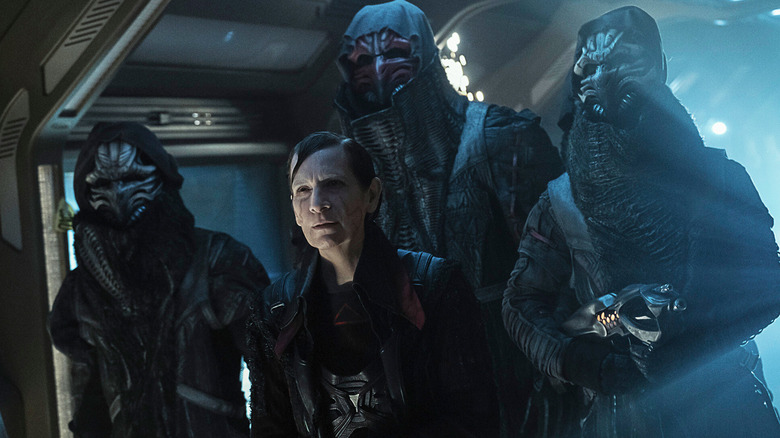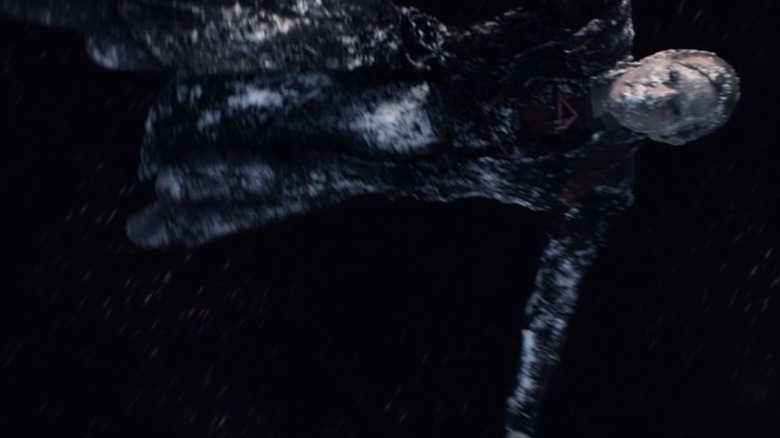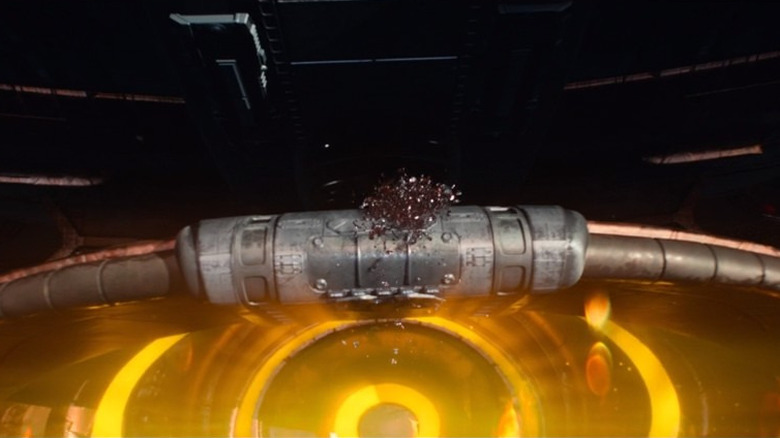Vadic's Biggest Scene In Star Trek: Picard Was Almost Too Expensive To Film
This post contains spoilers for the third season of "Star Trek: Picard."
Early in the third season of "Star Trek: Picard," audiences were introduced to Vadic (Amanda Plummer), a classic, snarling supervillain character. She sported a set of wicked scars on her cheeks, wore a dark cloak, combed her hair forward, and smoked cigarettes (a strange sight in the world of "Star Trek"). She was the captain of a massive, overpowered warship called the Shrike, which was armed with a strange portal-creating weapon and thousands of torpedoes.
As the series went on, it was revealed that Vadic was, in fact, a vengeful Changeling, a shapeshifter that has been subjected to sadistic medical experiments at the hands of an uncaring Federation doctor. She was leading a charge to destroy the Federation using the pilfered brain of Jean-Luc Picard (Patrick Stewart) and the eerie superpowers of his son, Jack (Ed Speleers). This led her to forcibly board the U.S.S. Titan and take its crew hostage. Vadic was one of the central villains of the season.
In the season's eighth episode, called "Surrender," Vadic was bested. While she was on the bridge of the Titan, the show's many heroes worked elsewhere to hack back into the ship's computers and engage a special, hidden airlock. By remote, a wall of the bridge suddenly opened directly into space, and Vadic was blown out into the vacuum. She flailed for a few moments before freezing solid. Her frozen body drifted through space over to the Shrike where she struck the hull. Vadic shattered into thousands of pieces.
According to a recent interview with Collider, "Picard" showrunner Terry Matalas explained that the visual effects required for the shattering sequence were incredibly pricey, and that he almost shot down the idea altogether.
'We can't do that'
While constructing the season, Matalas recalls the idea for Vadic's death being pitched to him, and that his initial reaction was ultimately very negative. It wasn't so much the concept of the scene — Matalas knew that the villain had to be defeated in a spectacular fashion — but the "shattering in the frozen hell of space" notion was something he didn't think "Picard" had the budget to properly visualize. He said:
"I didn't think we would be able to pull it off, visual-effects-wise, because it felt prohibitively expensive. But we have a brilliant team that was able to do it. In fact, when the writers pitched it to me, I was like, 'Are you guys crazy? We can't do that.' Then, to have her explode against the hull of the Shrike. I think, if I remember correctly, we were at the end of the season, I might have gotten really mad in the writers' room, being like, 'Guys,' but, it is undeniably satisfying to watch it happen."
Some Trekkies might posit that a Changeling could indeed survive being shattered, gathered up, and reconstituted, of course. Changelings are made of liquid, and freezing them shouldn't much affect their life cycle. Indeed, it was posited that Vadic in particular had been made more resilient as a result of her torturer's experiments, and there was footage of her being chipped apart in liquid form. But, as Matalas points out, Vadic's explosion does, in the moment, feel pretty definitive. Fans of "Picard" can likely rest assured that she won't be back for the show's remaining two episodes.
A budget-conscious approach
While "Star Trek: Picard" is one of the preeminent shows on Paramount+, and a large part of the ever-expanding "Star Trek" media empire, the producers still had to be budget-conscious. A lot of money likely went to the cast, which, in this season, consisted of most of the central actors from "Star Trek: The Next Generation" returning. One can see the frequent re-use of sets — Guinan's bar makes several appearances in both real-life and in holographic forms — which is in keeping with "Star Trek" traditions; many episodes took place entirely on the Enterprise, making use of maybe three or four already-constructed sets.
Matalas said he avoided multiple, large-scale starship battles for that very reason. The climax of "Picard" was constructed as a face-to-face, person-to-person fight instead. A single person exploding is less complicated than multiple starship explosions. He also said that Vadic's death was also constructed to raise new questions. Matalas said:
"In the episode, [there are] not a lot of space battles or anything, so maybe you could save your pennies to make it work? So, that's what we did. It definitely signals she's dead, which the audience should be going, 'Well, wait a second, she's dead, you blow up the Shrike, we still have two episodes left ... What's going on?' So, that was the thought process. It is definitely how you would kill the big boss, yet, what's going on?"
As of this writing, one additional episode of "Picard" has aired, and a new "big boss" has already been revealed beyond Vadic. The new villain is far less mysterious, as Trekkies will have seen them multiple times before. The next episode will be the show's last, so one can keep their fingers crossed and hope for a satisfying conclusion.


